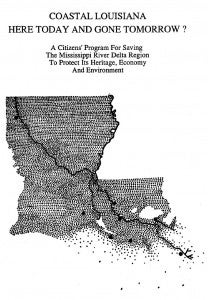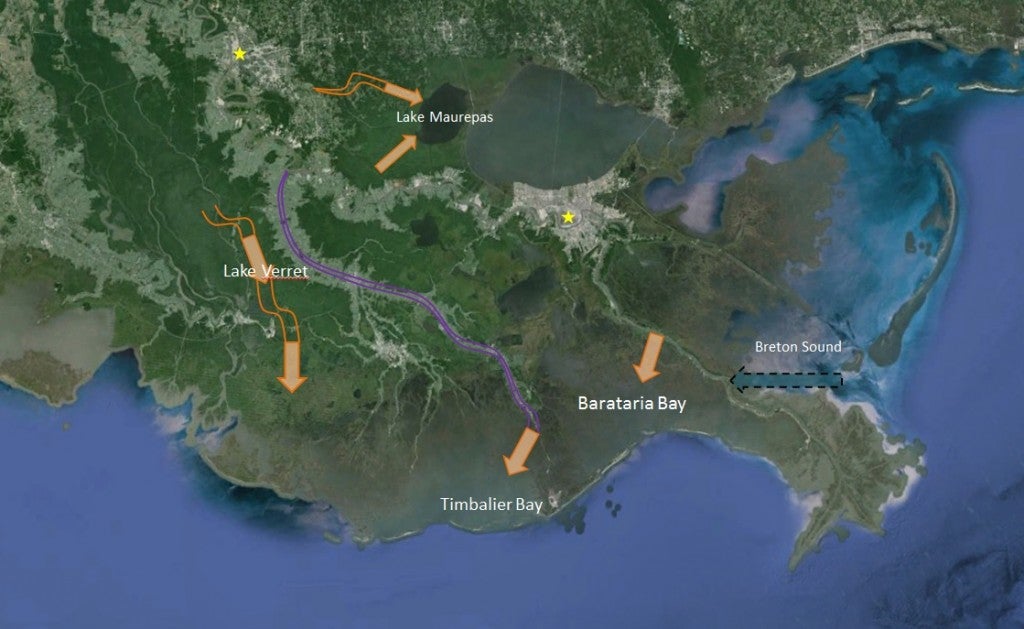Bold Recommendations & Early Citizen Support for Diversions as a Key to Coastal Restoration
By Estelle Robichaux, Restoration Project Analyst, Environmental Defense Fund and Gaby Garcia, Science Intern, Environmental Defense Fund
This post is part of a series on early restoration planning in Louisiana. Be sure to check out part one for a look back to 1973.
In 1988, the Coalition to Restoration Coastal Louisiana (CRCL) released a plan titled Coastal Louisiana: Here today and gone tomorrow? The plan, which was a joint effort by stakeholders and scientists, focuses on the Mississippi River Delta region and is framed as a citizens program for protecting Louisiana’s environment, economy and heritage.
economy and heritage.
The plan provides nearly 20 recommendations, including a restoration action program, suggestions for how to finance the program, as well as specific institutional and legislative recommendations designed to galvanize restoration.
Among the most notable elements is the assertion that sediment diversions would be the most beneficial method of wetland restoration and that several of them should be constructed along the Mississippi and Atchafalaya Rivers. This was also one of the first plans to advise against any new levee construction.
Many of the plan’s most significant propositions, those focused on restoration action, have yet to be realized, though the science behind sediment diversions is well developed and we continue to advocate for them as a sustainable restoration tool.
A bold but realistic plan of action
CRCL’s plan has two specific resource goals that are still strongly advocated for:
- To utilize freshwater and sediment diversions along the Mississippi River and Atchafalaya Rivers to sustain and restore coastal wetlands;
- To beneficially use dredged material from channel maintenance and existing spoil banks to backfill canals and nourish created wetlands and barrier islands
Restoring natural processes: Mississippi River water & sediment diversions
The Caernarvon and Davis Pond diversions were still being designed at the time this plan was published. Although there were expectations these structures would help control saltwater intrusion and reduce wetland loss, the plan underscores their limitations in active wetland restoration and land building. Despite the fact these diversions were designed for salinity and flood control, both areas have seen new land growth, though not at the scale or rate anticipated for sediment diversions.
The action program calls for the construction of a suite of freshwater and sediment diversions to restore hydrologic connections and halt wetland loss. The essence of many of these restoration ideas can be found in Louisiana’s 2012 Coastal Master Plan (CMP). Some of the restoration actions proposed in the 1988 plan include:
- One or two diversions from the Atchafalaya River into the Lake Verret Basin and Western Terrebonne marshes.
- 2012 CMP: Two diversions from the Atchafalaya will increase freshwater and sediment flows into Terrebonne marshes from Bayou Penchant westward, including our of our coalition’s 19 priority projects, Increase Atchafalaya Flow into Terrebonne Marshes.
- Restoration of Bayou Lafourche into a distributary of the Mississippi River, with a diversion into Timbalier Bay.
- 2012 CMP: Small-scale freshwater diversion from the river into Bayou Lafourche.
- Freshwater and sediment diversions, at Bayou Manchac and Blind River, to bring Mississippi River water into the degraded swamps south of Lake Maurepas.
- 2012 CMP: Two freshwater diversions, at Blind River and Hope Canal, and hydrologic restoration of the Amite River to restore freshwater inputs to Lake Maurepas, including one of our priority projects, West Maurepas Diversions.
- A large-scale sediment diversion of the Mississippi River below New Orleans into Barataria Basin and a navigation channel from the river into Breton Sound in the vicinity of Empire.
- 2012 CMP: Two sediment diversions into Barataria Basin in the vicinity of Diamond and Myrtle Grove, Lower and Mid-Barataria Sediment Diversions (also two of our coalition’s priority projects).
Beneficial use of dredged material
In addition to the focus on restoring natural processes by using freshwater and sediment diversions, the plan has another major component that concentrate on restoration actions that would provide short-term benefits as well as some regulatory changes. This component focuses on using dredged sediments, taken from the bottoms of canals or by removing spoil banks, for restoration efforts.
It is recommended that all dredged material from channel maintenance work should be used for wetland creation and restoration. Sediment from spoil banks would be used to plug many of the abandoned canals along the coast, which would also provide hydrologic restoration of freshwater flow across the affected marshes.
Looking back, moving forward
As we review these early restoration plans, it becomes clear that using water and sediment from the Mississippi River to restore Louisiana’s coastal wetlands is not a new idea. Diversions have long been a key component in coastal restoration planning, though they are only one of the suite of tools we can use.
Restoration planning has spanned more than four decades in Louisiana, but it is only in the last two that consistent funding became available. Check out our next post for more on funded restoration programs in Louisiana.
